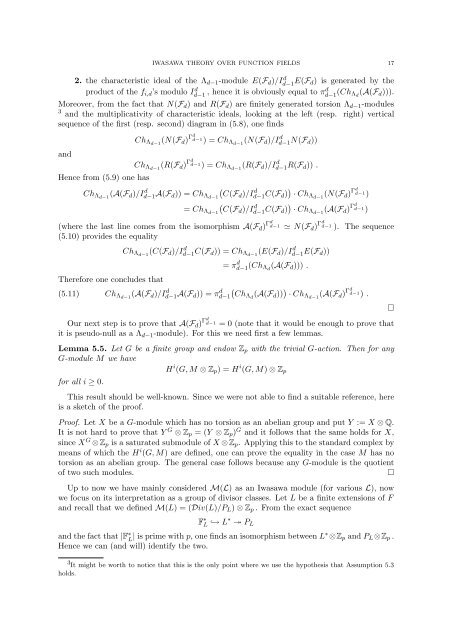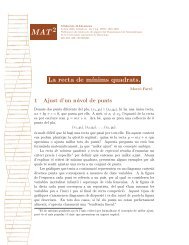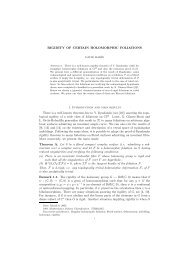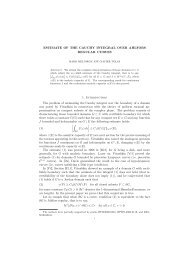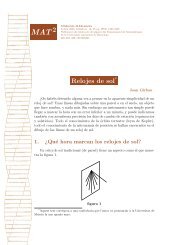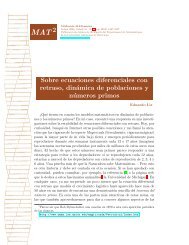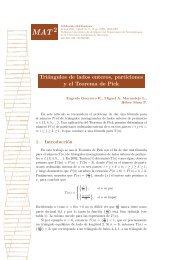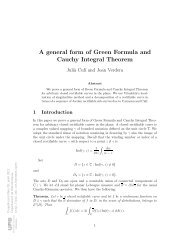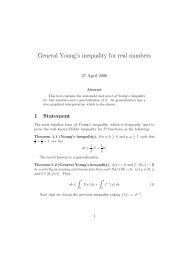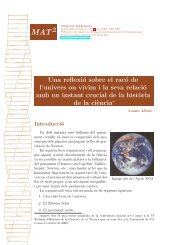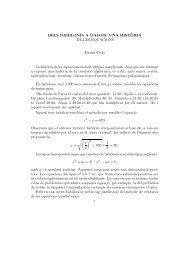ASPECTS OF IWASAWA THEORY OVER FUNCTION FIELDS 1 ...
ASPECTS OF IWASAWA THEORY OVER FUNCTION FIELDS 1 ...
ASPECTS OF IWASAWA THEORY OVER FUNCTION FIELDS 1 ...
Create successful ePaper yourself
Turn your PDF publications into a flip-book with our unique Google optimized e-Paper software.
<strong>IWASAWA</strong> <strong>THEORY</strong> <strong>OVER</strong> <strong>FUNCTION</strong> <strong>FIELDS</strong> 172. the characteristic ideal of the Λ d−1 -module E(F d )/I d d−1 E(F d) is generated by theproduct of the f i,d ’s modulo I d d−1 , hence it is obviously equal to πd d−1 (Ch Λ d(A(F d ))).Moreover, from the fact that N(F d ) and R(F d ) are finitely generated torsion Λ d−1 -modules3 and the multiplicativity of characteristic ideals, looking at the left (resp. right) verticalsequence of the first (resp. second) diagram in (5.8), one findsandHence from (5.9) one hasCh Λd−1 (N(F d ) Γd d−1 ) = ChΛd−1 (N(F d )/I d d−1 N(F d))Ch Λd−1 (R(F d ) Γd d−1 ) = ChΛd−1 (R(F d )/I d d−1 R(F d)) .Ch Λd−1 (A(F d )/I d d−1 A(F d)) = Ch Λd−1(C(Fd )/I d d−1 C(F d) ) · Ch Λd−1 (N(F d ) Γd d−1 )= Ch Λd−1(C(Fd )/I d d−1 C(F d) ) · Ch Λd−1 (A(F d ) Γd d−1 )(where the last line comes from the isomorphism A(F d ) Γd d−1 ≃ N(Fd ) Γd d−1 ). The sequence(5.10) provides the equalityCh Λd−1 (C(F d )/I d d−1 C(F d)) = Ch Λd−1 (E(F d )/I d d−1 E(F d))= π d d−1 (Ch Λ d(A(F d ))) .Therefore one concludes that(5.11) Ch Λd−1 (A(F d )/Id−1 d A(F d)) = πd−1d (ChΛd (A(F d )) ) · Ch Λd−1 (A(F d ) Γd d−1 ) .□Our next step is to prove that A(F d ) Γd d−1 = 0 (note that it would be enough to prove thatit is pseudo-null as a Λ d−1 -module). For this we need first a few lemmas.Lemma 5.5. Let G be a finite group and endow Z p with the trivial G-action. Then for anyG-module M we haveH i (G, M ⊗ Z p ) = H i (G, M) ⊗ Z pfor all i ≥ 0.This result should be well-known. Since we were not able to find a suitable reference, hereis a sketch of the proof.Proof. Let X be a G-module which has no torsion as an abelian group and put Y := X ⊗ Q.It is not hard to prove that Y G ⊗ Z p = (Y ⊗ Z p ) G and it follows that the same holds for X,since X G ⊗ Z p is a saturated submodule of X ⊗ Z p . Applying this to the standard complex bymeans of which the H i (G, M) are defined, one can prove the equality in the case M has notorsion as an abelian group. The general case follows because any G-module is the quotientof two such modules.□Up to now we have mainly considered M(L) as an Iwasawa module (for various L), nowwe focus on its interpretation as a group of divisor classes. Let L be a finite extensions of Fand recall that we defined M(L) = (Div(L)/P L ) ⊗ Z p . From the exact sequenceF ∗ L ↩→ L ∗ ↠ P Land the fact that |F ∗ L | is prime with p, one finds an isomorphism between L∗ ⊗Z p and P L ⊗Z p .Hence we can (and will) identify the two.holds.3 It might be worth to notice that this is the only point where we use the hypothesis that Assumption 5.3


